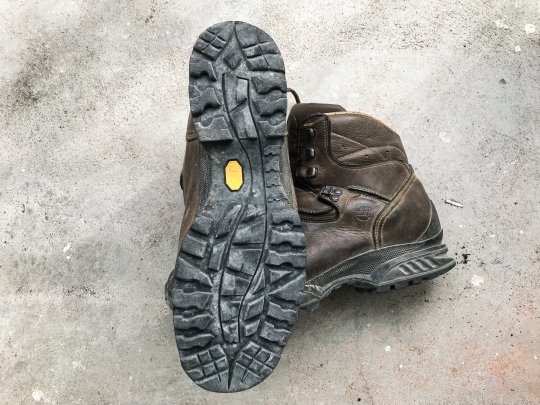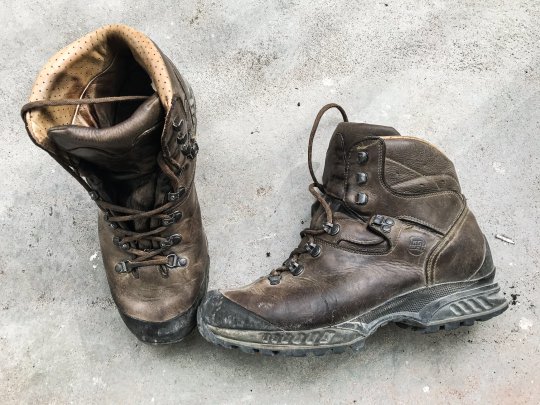Mountain boots | Buying new ones
The adrenaline rushes through your body. A big swirl in the water and a rod that bends completely... Another thick pike on the line! I used to love catching big fish. Unfortunately, it often happened that my line broke and I was left in a bad mood. Best advice I got then:
'Your fishing line is your direct connection to the fish, so never save on this and go for the best quality!
I also took this advice with me to mountain hiking. Your shoes are your direct connection to the mountain and so on...
Don't save on mountain boots!
It's a sustainable investment that can provide 1500 kilometers of hiking fun just like that. This blog explains what to look out for when buying good mountain hiking boots.
Tip 1 – Determine at which level you want to go mountain hiking
Just like any other hobby, you can make it as crazy as you want with mountain hiking. There are shoes of 50 euros but also 500 euros and therefore it is important that you know what kind of hiker you are. The Nijmegen four days are not going to be walked on the same shoes that will bring you to the top of Kilimanjaro. Think in advance what kind of hiker you are!
Good questions to ask yourself are;
- Do I often deviate from the beaten track?
- How long are my hikes on average?
- What level of difficulty do my hikes have?
- Do I walk when it rains / do I walk through wet grass?
- Am I going through areas where I need to clatter?
- Do I walk on glaciers (where I need crampons)?
- How much difference in height is there in my routes?
Mountain boots categories
Luckily it's made easy for you. Mountain hiking boots are divided into five main categories: A, A/B, B, C, D. By asking the right questions, you'll soon know which category of hiking boots you can use for your routes. Below is a short explanation of each category.
Category A: Low mountain boots suitable for short walks. The shoes are flexible and cushion your feet. This category is suitable for hiking in a forest or in the city.
Category A/B: Semi-high mountain hiking boots with a sturdy profile. Is suitable for multi-day treks on unpaved paths. Category B: Firm high shoe with extra stiff sole. Suitable for long mountain hikes with a lot of height difference.
Category C: If you are going to make challenging mountain tours and sometimes have to tie crampons underneath because you are walking on a glacier you need at least this category. Anyway, for technical climbing this category is a plus because the material is extra strong and the mountaineering shoe is very stiff.
Category D: Actually, this category is the superlative of category C. The mountain shoe is standard rigid and has a very stiff sole. The mountain boots are waterproof and well insulated and that's great when you're climbing high in the snow.
The Hanwag Lhasa mountain boots
I like to walk on Hanwag mountain shoes in the category B. the Hanwag Lhasa. These are fairly high mountain shoes with a stiff sole and a good profile, suitable for medium to heavy mountain hikes, but also on flatter terrain this shoe feels very supple because the nose rises a little. I consciously chose waterproof mountain hiking boots because I like to walk in rain or wet grass. Think about this carefully because it does make the mountain shoe warmer.
I wear size 44.5 and wear normal shoes size 43.



Tip 2 – Buy your mountain boots a little too big
Anyone who ever walks in the mountains knows that after a few hours of walking your feet would do just fine as a stove in a cold Russian winter. No wonder you see all those hikers looking for coolness in such a cold stream!
Warm feet expand considerably. So you'll need bigger shoes than you think when you try them on. Make sure you can always move your toe freely in the shoe. Especially when you go down there will be more pressure on the forefoot and toes. The last thing you want is a squeezing shoe and an injured toe full of blisters. I always keep half a toe space at the front. Still, it's not just a well walked-in shoe that will help you get through your walk without blisters.
Also invest in a good sock. A good sock often costs around 25 euros and a cheap sock €5. That's quite a big difference. Fortunately, the amount of 25 euros is definitely worth it.
Pay attention when picking out your socks;
- Preformed sock for the left and right foot
- Thick damping pieces at the pressure points of your foot
- Breathable material or Coolmax technique
- Your personal preference for a high or low sock
Tip 3 – Get some advice from a mountain climbing salesman
At 'De Bever' I decided to choose one of the three big brands; Meindl, Lowa and Hanwag. Many people who work at de Bever also have personal affinity and experience with the department in which they work. So there's a good chance that the walking shoe retailer knows all about this, also from practical experience! Meindl was top of mind when it came to branding, but the fit just turned out to be too wide. I found Lowa a bit too stiff to fit and with Hanwag I immediately had the feeling that I had good contact with the ground surface, and also had good support. But yes, that's purely personal and you'll have to experience that for yourself. Usually you can take a new shoe with you, try it on inside your own house for a while and then exchange it for another shoe if it does not feel right after all. After a few bumps up and down the stairs you can make a more informed decision for your favorite, high quality walking shoe!
